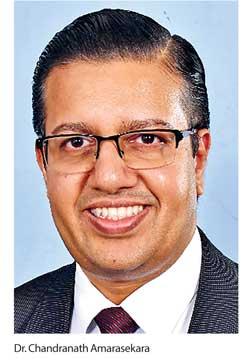10 Feb 2021 - {{hitsCtrl.values.hits}}
Responding to concerns raised by some sections on the potential of interest rates to increase towards the second half of the year, the Central Bank said the consumer prices, which is the often-used gauge to guide interest rates by the Monetary Board, do not signal nor make a case for a reversal in the current monetary policy.

However, some economists, analysts and even banks have begun to feel that the current downward trend in interest rates is nearly coming to an end, and could even reverse course from the second half of the year.
“We earnestly hope that this low interest rate regime can be sustained in the period ahead as well because we are confident of maintaining inflation between 4-6 percent. Based on that the interest rates should also be in the single digits,” said Dr. Chandranath Amarasekara, Director of Economic Research at the Central Bank speaking at a webinar organised by CMA Sri Lanka, yesterday.
Sri Lanka has had single digit inflation for 12 years and the Monetary Board has expressed confidence in keeping inflation at mid-single digit levels throughout the end of this year.
Under the inflation-targeting regime, the monetary policy is predominantly guided by consumer prices instead of a monetary target as in the past.
However, critics argue that the pressure on the currency as a result of importer dollar demand, and impending foreign debt repayments amid still sub-par dollar inflows would push interest rates upwards towards the second half of the year.
Others put the blame on massive Central Bank liquidity created through 2020 for deficit financing via a mechanism known as ‘Modern Monetary Theory,’ as record money supply could revitalise inflation and put pressure on the currency through higher imports.
However, imports have remained subdued thus far due to restrictions on non-essential imports and the lower oil bill. But crude oil prices at Brent futures exchange this week hit pre-pandemic level of US$ 60.11 a barrel after remaining below that level for over an year, due to prospects of faster than expected global economic recovery.
Meanwhile, any potential supply shocks in the domestic market could also flare up inflation forcing interest rates to go up.
Sri Lanka now has the lowest interest rates on record in the history as a result of the unprecedented monetary support extended by the Central Bank since last March.
Meanwhile, another source of inflation is the fall in unemployment or near-full employment, which occurs roughly when unemployment falls below 4.0 percent, which is identified through what is called the ‘Phillips Curve,’ named after the late economist A.W. Phillips, who observed the interplay between jobs and wages in the UK in the 1800s and early 1900s.
However, central bankers in the developed markets are trying without success to get the inflation back up even to 2.0 percent levels for more than a decade even with unemployment at 3.0 percent, record stimulus and near zero interest rates.
Central bankers walk a tight rope in finding the sweet spot in interest rates, which neither overheats the economy nor undermines the growth by setting a higher rate, which kills jobs and businesses.
20 Nov 2024 13 minute ago
20 Nov 2024 15 minute ago
20 Nov 2024 45 minute ago
20 Nov 2024 54 minute ago
20 Nov 2024 2 hours ago